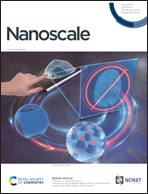Triplet properties and intersystem crossing mechanism of PtAg28 nanocluster sensitizers achieving low threshold and efficient photon upconversion†
Abstract
Ligand-protected metal nanoclusters have emerged as a promising platform for providing sensitizers for triplet–triplet annihilation upconversion (TTA-UC). Herein, we report [PtAg28(BDT)12]4− (PtAg28; BDT = 1,3-benzenedithiolate) as a sensitizer enabling TTA-UC at low excitation intensities. PtAg28 exhibits a long-lived triplet state (approximately 7 μs) generated with a 100% intersystem crossing (ISC) quantum yield. The mechanism driving this efficient ISC was unveiled with the aid of theoretical calculations. Specifically, the S1–T1 ISC reveals a small spin–orbit coupling (SOC) matrix element, attributed to their similar electron configuration. In contrast, the T2 state, which is energetically close to S1, features a hole distribution derived from the Py superatomic orbital of the icosahedral Pt@Ag12 core. This distribution enables direct SOC based on the orbital angular momentum change from the S1 state with a Pz-derived hole distribution. Consequently, the efficient ISC was rationalized by the S1 → T2 → T1 pathway. The T1 state possesses a metal core-to-surface metal charge transfer character, facilitating triplet energy transfer and conferring superior sensitization ability. Leveraging these characteristics, the combination of PtAg28 sensitizer with a 9,10-diphenylanthracene annihilator/emitter attained an extremely low UC threshold of 0.81 mW cm−2 at 532 nm excitation, along with efficient green-to-blue TTA-UC with an internal quantum yield (ΦUCg) of 12.2% (50% maximum). This results in a pseudo-first-order TTA process with strong UC emission under 1-sun conditions.



 Please wait while we load your content...
Please wait while we load your content...